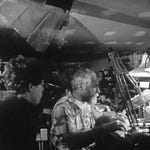————-
Excerpted from 12 Dead Frogs.
JOE’S SANDWICHES (1969)
Because I wasn’t in any hurry (going nowhere) that summer of’69, I was able to really soak up everything there was to learn on my walks. When I entered a store I wasn’t trying to duck in and out as quickly and efficiently as possible like I do now. I would enter, sniff the air, look at the people and things, really experience the present-tense moments of being there. One day I discovered a great little corner market run by an old Italian guy named Joe, near where Telegraph Avenue and Claremont Avenue intersected off 51st Street in Oakland. The place was a real time-warp inside -- it felt like it was still 1938!
The total opposite of today’s spacious modern supermarket, Joe’s market was a small, dark, cocoon of a place, and in the middle of the limited floor space, one free-standing section of shelving filled with cans, bottles, and boxes adorned with old foreign- looking labels, many written in Italian. The wide wooden shelves which lined the walls, except where the refrigerated meat counter blocked the rear exit, were also stocked to the gills with an odd assortment of foodstuffs, other items half-concealed behind the hanging salamis, brooms, and a myriad of items suspended from hooks. There was even a rack of hundreds of greeting cards from the 1930s, their quaint phrases reflecting a completely different sensibility than existed at the present time (Joe later offered me the entire rack for $5, which I bought and packed away, thinking they might be fun conversation pieces).
Cover and inside look––one of Joe’s cards (and sentiment), from the 1930s-40s.
But probably most amazing of all was that Joe sold his home-made sandwiches for only a quarter apiece. Even in the late 1960s that had to be considered very cheap (a nearby deli sold just one French roll bun, empty, no contents, for the same 25 cents). I soon learned that every lunch hour there was a little line out his door, mostly consisting of working people in suits and ties, nice-looking secretaries, all waiting for Joe’s “three kinds of meat, three kinds of cheese, a half-tomato on a French roll.” It was incredible!
As I traveled between Telegraph and Broadway, College Avenue and Claremont, I would sooner or later drift by Joe’s for my sustenance. Each day I would buy a sandwich, a small milk, a banana, plus an occasional almond cookie (all for about 50 cents). I’d eat half the sandwich around noon, the rest at different points in the day, taking a bite whenever I got hungry and then wrapping it back up again. And as one always feels with such an extremely good deal, I had a funny sensation that I was getting away with something. Didn’t he know that sandwiches like that always cost more than $1.50? Was he stupid? Or just behind the times? How could he do it? No one knew.
Joe even allowed me to piddle around the store, and occasionally work off a portion of my daily sandwich. One day I spent about an hour or so chipping the ice off the sides of an ancient freezer unit that held the popsicles and ice cream sticks. The ice had accumulated so much over the years that it was about a foot thick! In any case, I helped out and got a small deduction on my meals. And I got to know Joe well enough to see beyond his often-brusque manner. He hardly had two words for any customer, but he was always nice to me and I came to care for him. How could you not care for someone who was helping you survive.
After I’d known Joe for a couple of months he explained that he had worked that store for twenty- five years. Before I could exclaim at his longevity he further explained how he had started his grocery business next door (what was then an All State Insurance company), and had been there an additional thirty-nine years. I tried to comprehend those numbers. He had spent 64 years (more than double my lifetime), running his stores. I doubted that I would even live that long.
Over the span of my visits I noticed that many of his customers were older Italian-looking senior citizens who would come in to pick up grocery bags full of food, quickly signing their name in a long, skinny old ledger while other customers were kept waiting. I never saw any of these old Italians give Joe even a nickel. They just got their food, signed in, thanked him with a short nod or grunt, and left. Once, when that book was angled slightly toward me, I saw it was filled with names by the dozens, tiny signatures scrawled on close-fitting lines, numbers and dates piled high to the right in a tall column. By the looks of the warped pages, bubbling against the unused ones toward the rear cover, the old book had been used for decades.
In August, when I was lucky enough to be hired by my school to work with some sculpture buddies setting tile into a patio for minimum wage, I got the urge to show Joe’s sandwiches off, and invited two other worker friends to join me in the cheapest lunch they’d ever have. I enjoyed seeing their delighted and dazed faces as I came away from the counter holding their fat meat and cheese sandwiches that only cost them 25 cents apiece. They couldn’t believe it any more than I ever had. Oh, I was smart, the clever one. Didn’t I know the cheapest place in town? But before I had much time to bask in my glory, Joe called me back over to the end of the counter, keeping other customers waiting. I couldn’t understand what he could want to talk to me about. In a loud whisper he hoarsely said, “Don’t you ever bring anyone in here for sandwiches like that again!”
I was momentarily shocked by the intensity of his words, and mortified that he was angry with me. But he still had more to say.
“Don’t you know it costs me more than 25 cents to make those sandwiches?” he said, looking me right in the eyes. Oh my God! I thought to myself, He’s known all along. No one was ever getting away with anything!
I started to say, “But...,” (my speech stumbling), but no more words came out. My mind refused to operate. Finally, the word, “Why?” escaped my lips.
With an expression of pity mixed with disgust, Joe finished me off.
“Don’cha yuh know dat somebuddy’s gotta do sometin’ for dis country?”
————
What amazon has to say about “FROGS”memoir:
No-budget feature filmmaker Rick Schmidt has written a fascinating memoir, TWELVE DEAD FROGS AND OTHER STORIES, which, he hopes, will "fill in the blanks" on how he learned the tools of the trade and shared them in his seminal how-to, Feature Filmmaking at Used-Car Prices (Viking Penguin, 1988, 1995, 2000). Schmidt's outside the box approach has resulted in the launch of countless moviemaking careers, for those who put his ideas into practice. Some notables include writer/director and action-star Vin Diesel (THE FAST AND FURIOUS, PITCH BLACK, GUARDIANS OF THE GALAXY), Edward Sanchez (THE BLAIR WITCH PROJECT), Tom DeCillo (LIVING IN OBLIVION). Academy Award(TM) winning cinematographer Vilmos Zsigmond declared, "I wish I could have had this book thirty-five years ago, before I made my first low-budget features." And writer/director Kevin Smith (CLERKS, CHASING AMY, DOGMA), Kevin Smith presented Schmidt with a Lifetime Achievement Award at Rome international film Festival, which should help explain the book's and Schmidt's wide appeal.
———-
















Share this post